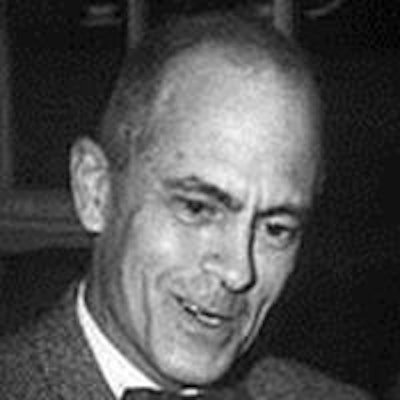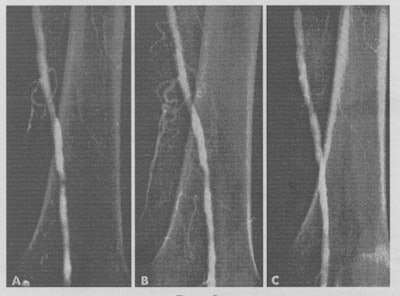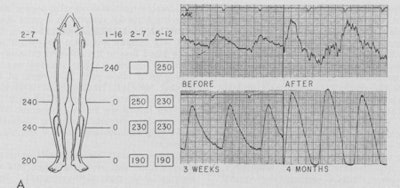
Everything changed for radiology on 16 January 1964. It was on this day that Dr. Charles Dotter performed the first ever percutaneous transluminal angioplasty (PTA). In the early years of radiology, the purpose of vascular catheterization was diagnosis, but following Dotter's breakthrough, catheterization increasingly became a prelude to intravascular intervention.
Fifty years ago, radiologists' ability to diagnose vascular disease was far greater than their ability to treat patients. This concerned Dotter, who set his mind to the problem, and so PTA was born.
 Dr. Charles Dotter, 1920-1985.
Dr. Charles Dotter, 1920-1985.
Dotter's first patient was a chronically bedridden 82-year-old woman with peripheral vascular disease and a painful and ulcerated foot. The foot was pulseless, and there was a 2 x 4-cm ulcer and three ischemic toes.
Dotter stepped in and proved the clinical utility of PTA. He performed diagnostic angiography on 6 January 1964, and a 0.5-cm atheromatous obstruction of the superficial femoral artery at the level of the adductor hiatus was shown. The lumen was barely discernible, and the peripheral vessels filled only slowly. All seemed hopeless and the surgeon had recommended amputation, but the patient refused surgery.
Ten days later, Dotter performed a percutaneous transfemoral catheter dilatation of the segmental femoral narrowing, and he recorded that it took only a matter of minutes and was performed without difficulty. When the dilating catheter was removed, good pulses were palpable for the first time in the lower leg and foot. Angiography revealed that the stenosis was no longer present. There was immediate diminution in pain, discoloration, and coldness of the foot. During the week after the procedure, there was rapid healing of the ischemic skin changes, including the ulceration of the lower leg.
A follow-up angiogram was performed on 6 February, three weeks postprocedure, and the lumen remained patent. At eight months, the patient was ambulatory, the ulceration was gone, the gangrenous toes had separated, and the sites were healed. The patients' pain disappeared, and she was able to walk until she passed away three years later.
 Case one from Circulation, published in November 1964. A: The control angiogram showing threadlike lumen in the region of the adductor hiatus. B: The angiogram performed immediately after dilatation with a 3.2-mm OD catheter. C: The angiogram performed at three weeks.
Case one from Circulation, published in November 1964. A: The control angiogram showing threadlike lumen in the region of the adductor hiatus. B: The angiogram performed immediately after dilatation with a 3.2-mm OD catheter. C: The angiogram performed at three weeks.The classic paper on Transluminal Treatment of Arterial Obstruction appeared in Circulation in November (1964, Vol. 30, pp. 654-670), and a total of 10 cases were described. Dotter and co-author Dr. Melvin Judkins wrote in the opening paragraph: "Despite the frequency and importance of arteriosclerotic obstruction, current methods of therapy leave much to be desired. Nonsurgical measures, however helpful they may be, provide the patient little more than an opportunity to live with his disease."
The paper gave a detailed account of the technique used. Dotter advised prior retrograde angiography to ensure a hematoma-free artery on the side to be treated. The procedure utilized an antegrade catheterization and dilatation of the atheromatous block using a tapered and radiopaque Teflon dilating catheter. Following successful dilatation, he noted "the patient will happily announce the return of adequate blood flow to the troubled extremity."
The procedure could sometimes be completed in 10 or 15 minutes, he added. Many of his patients were diabetic and had been rejected for definitive surgery and were scheduled for amputation. It is interesting to note that he recorded that failure of his technique was not associated with harm to the patient.
Dotter stated: "It seems reasonable to expect that the transluminal technique for recanalization will extend the scope of treatment beyond the limits of present-day surgery. The method offers early treatment of the ischemic leg. In view of its simplicity and low morbidity, it is now feasible to treat intermittent claudication without waiting for more serious symptoms to occur or collateral circulation to develop." He predicted that PTA would become the treatment of choice for patients suffering from arteriosclerotic ischemia of the lower extremities.
 Objective measurements show objective improvement. Blood pressure measurements are recorded as well as plethysmographic waveforms.
Objective measurements show objective improvement. Blood pressure measurements are recorded as well as plethysmographic waveforms.Some of Dotter's colleagues questioned the value of catheter recanalization on the grounds that coexistent disease in distal branches defeats its purpose. However, he pointed out it was a simple physical fact that removing a proximal, gradient-producing stenosis results in an increase in the distal blood pressure and therefore an increase in the flow of all patent run-off branches, whether they are narrowed or not. As Dotter said, "Even a rusty sprinkler may prove capable of doing a creditable job once the faucet is fully opened!"
The technique of PTA became known as "Dottering," and considerable success was achieved in Europe and elsewhere. Unfortunately, in the U.S. the technique did not become popular until the mid-1970s, and many saw it as a short-lived fad. There was obviously reluctance on the part of surgeons in the U.S. to refer patients for PTA. In one well-known request to Dotter for a left femoral arteriogram from 1964, the following text on the request form was written in capitals and underlined: "VISUALIZE BUT DO NOT TRY TO FIX!"
Many have followed Dotter in developing vascular intervention, including the use of balloon catheters and stents. As he predicted, "No doubt the interest and ingenuity of others will lead to refinements of technique as well as further clarification of the role of this attack on arteriosclerotic obstructions."
The many thousands of angioplasties performed each year all over the world are a lasting memorial to Dotter's tremendous achievement.
Dr. Adrian Thomas is chairman of the International Society for the History of Radiology and honorary librarian at the British Institute of Radiology.
Further reading
- Thomas AMK, Banerjee AK. The History of Radiology. Oxford, U.K.: Oxford University Press; 2013.
- Thomas AMK, Banerjee AK, Busch U. Classic Papers in Modern Diagnostic Radiology. Berlin, Germany: Springer Verlag; 2004.
The comments and observations expressed herein do not necessarily reflect the opinions of AuntMinnieEurope.com, nor should they be construed as an endorsement or admonishment of any particular vendor, analyst, industry consultant, or consulting group.



















